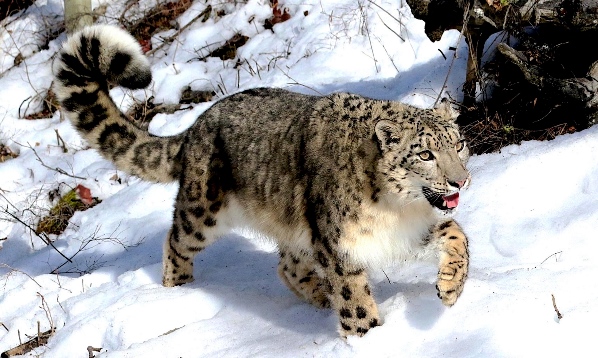Although the survival of the snow leopard (Panthera uncia; formerly, Uncia uncia), also known as the ounce, is precarious, the International Union for Conservation of Nature and Natural Resources (IUCN) has assigned an upgraded status—"vulnerable"—to this wild felid, which had been previously classified as "endangered." Statistically, the population of snow leopards may be declining overall, but conservation efforts and antipoaching enforcement have improved conditions in a number of key areas where this big cat is found. Inhabiting the high-altitude mountainous regions of central Asia, including Afghanistan, Bhutan, China, India, Kazakhstan, Kyrgyzstan, Mongolia, Nepal, Pakistan, Russia, Tajikistan, and Uzbekistan, the snow leopard still faces extinction in the wild, but the probability of this outcome has been lessened somewhat by recent observational data that have allowed a reclassification. Specifically, populations of snow leopards have stabilized or even improved in certain regions, with experts estimating between 4000 and 10,000 individuals remaining in the wild; the current best estimate is 7400 to 8000 animals. In general, the IUCN's Red List of Threatened Species, the foremost inventory of the world's animal and plant species, assigns a status of "endangered" to animals having fewer than 2500 individuals in the wild. As this is no longer thought to be the case for the snow leopard, its status has been changed to "vulnerable." See also: Cat; Conservation (species); Endangered species; Extinction; Population ecology

However, not all conservationists agree with this reclassification because the animal has suffered a population decline of 10% over the past three generations (22.62 years) and is still faced with a projected decline (although possibly at a rate lower than 10%) over the next three generations. This is hardly a satisfactory prospect for the snow leopard's viability. Thus, certain researchers believe that the reassignment of the wild cat's status from endangered to vulnerable will hinder and weaken the conservation programs that are now in place and will enable governments to eliminate the monetary and personnel resources that have helped to preserve the snow leopard across its range. In addition, it is possible that any policies that de-emphasize the threats faced by this big cat will lead to increased incidents of poaching and habitat destruction, which are the two leading causes for the snow leopard's decline in numbers. Therefore, the change in the classification status of the snow leopard is not a reason for celebration; rather, strong conservation efforts must persist to ensure the animal's survival. See also: Ecological modeling; Environmental management; Population genetics; Population viability; Predatory feline genes





